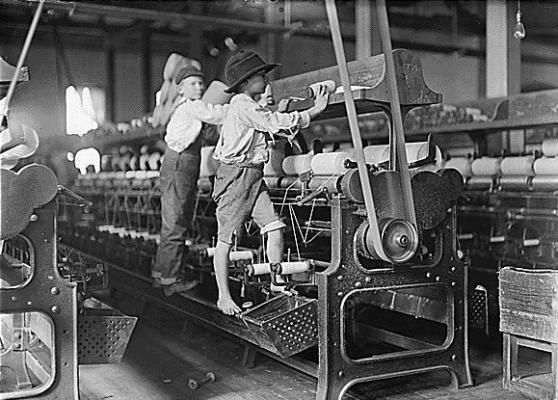THE Industrial Revolutionbegan in the second half of the 18th century, in England, causing profound changes in technology by enabling the improvement of techniques for production and more advanced machines.
Furthermore, with the rise of the working class, the Industrial Revolution established new labor relations and growing social inequality.
We already know that the Industrial Revolution had three phases: the First Industrial Revolution (1760 to 1850), the Second Industrial Revolution (1850 to 1950) and the Third Industrial Revolution (half of the 20th century to the present day).
Questions about the Industrial Revolution
The time has come to measure our knowledge of each of these moments. Come on?
1) (Unesp) “The superiority of English industry in 1840 was not challenged by any imaginable future. And this superiority would only have to gain if raw materials and foodstuffs were cheap. This was no illusion: the nation was so satisfied with what it considered an outcome of its policy that criticism was almost silenced until the depression of the 1980s.” (Joseph A. Schumpeter, "HISTORY OF ECONOMIC ANALYSIS")
From this exhibition it is concluded why England decidedly adopted, from 1840 onwards, the:
a) isolationism in its foreign policy
b) state interventionism in the economy
c) monopoly capitalism against competition
d) aggressive militarism in the conquests of overseas colonies
e) free trade in the relationship between nations
2) (Uel) One factor that contributed decisively to the industrialization process in eighteenth-century England was:
a) the accumulation of capital resulting from the colonial exploitation practiced by England through trade
b) the technological competition between British and Americans, which stimulated economic development
c) the expulsion of Napoleonic troops from English territory, which united national interests around a development effort
d) the Luddist movement in England with the destruction of machines considered obsolete, by encouraging the invention of new machines
e) the opening of markets in Germany and France to England, through a commercial agreement known as the Berlin Pact
3) (PUC-Campinas) Among the social consequences wrought by the Industrial Revolution we can mention:
a) the development of a social layer of workers, who, deprived of the means of production, started to survive only from the sale of their labor force
b) the improvement of housing and survival conditions for the working class, provided by the surge in economic development
c) the social ascension of artisans who gathered their capital and tools in workshops or scattered rural households, increasing domestic production nuclei
d) the creation of the Bank of England, with the objective of financing the monarchy and also being an institution that generates jobs
e) the development of petrochemical industries favoring the organization of the labor market, in order to ensure employment to all salaried workers
4) (Aman-2015) The accumulation of capital, the modernization of agriculture, the availability of labor and resources natures and the strength of Puritanism help explain __________'s pioneering in the Revolution Industrial. BOULOS Jr, p.421
Of the options listed below, the country that best fills the space above is:
the Germany
b) Netherlands
c) Italy
d) England
e) Spain
5) (UFG-2013) Read the information below.
In the mid-eighteenth century, James Watt patented his invention in England, about which he wrote to his father: “The business I am in now has become a great success. The fire machine I invented is working and getting a much better response than any that has been invented so far.”
The historical revolution related to the text, the primary source of energy used in such a machine and the environmental consequences of its use are, respectively:
a) puritan, natural gas and increased occurrence of thermal inversion
b) glorious, oil and ozone layer depletion
c) glorious, coal and increased melting of the polar ice caps
d) industrial, natural gas and atmospheric moisture reduction
e) industrial, coal and increased air pollution
6) (Uerj-2011) The 1889 Paris Exhibition centered on Gustave Eiffel Tower, 300 m high, over 7,000 tons and over a million rivets. It had two long galleries devoted to the Fine Arts and the decorative arts; behind it was the imposing “Palácio das Máquinas”. Adapted from http://www.esec-josefa-obidos.rcts.pt
International exhibitions began in London in 1851. The Eiffel Tower, one of the symbols of the city of Paris, was erected for the 1889 exhibition, commemorating the centenary of the French Revolution.
During the European capitalist expansion in the 19th century, these exhibitions aimed to highlight the importance of:
a) Franco-British financial cooperation
b) technological modernization of production
c) consolidation of bourgeois democracies
d) standardization of development standards
7) (PUC-SP) For the industrialization process in eighteenth-century England, it was decisive (a):
a) the colonial relationship, maintained with India and North America, which allowed a large accumulation of financial resources
b) the encouragement of English development, promoted by technological competition with the Americans
c) the union of national interests around a development effort, soon after the expulsion of Napoleonic troops from English territory
d) the incentive to technological innovation as a result of the action of the Luddites who destroyed the machines considered obsolete
e) the trade agreement known as the Methuen Treaty, which established the opening of German markets
8) (PUC-Campinas) The new production process introduced with the Industrial Revolution in the 18th century was characterized by:
a) implementation of rural domestic industry to replace workshops
b) production in large manufacturing units and intense division of labor
c) mechanization of agricultural production and consequent fixation of man on the land
d) ease of purchase of machines by artisans who were able to obtain financing for this
e) concern to increase production, respecting the limit of the worker's physical strength
9) (Mackenzie) Among the achievements of the Meiji Era (Age of Enlightenment), unleashed by Emperor Mitsu-Hito aiming modernize Japan to compete on equal terms with the industrialized countries of the West, we highlight:
a) abolition of serfdom, proclamation of the equality of all Japanese before the law, development of public education, communications and the economy
b) strengthening the power of the Shogunate and opening the ports to foreign products, aiming to assimilate Western technology
c) creation of independent Daimios, coordinated by an imperial Shogun charged with stimulating the activities of urban centers of industrial production
d) policy of financial incentives to the national bourgeoisie, formation of a supranational regional economic bloc (the Asian Tigers), expanding relations between East and West
e) economic reform, creation of the Yen, institution of serfdom in industries, and cession of the island of Hong Kong to England, in exchange for financial loans
10) (Enem) The Second Industrial Revolution, at the end of the 19th century and beginning of the 20th century, in the USA, a period in which electricity gradually started to make part of the daily life of cities and feeding the engines of factories, was characterized by the scientific administration of work and production in series. MERLO, A. A. Ç.; LAPIS, N. L. Health and work processes in capitalism: reflections on the interface between the psychodynamics of work and the sociology of work. Psychology and Society, no. 1, Apr. 2007.
According to the text, in the first half of the 20th century, capitalism produced a new geoeconomic space and a revolution that is related to:
a) proliferation of small and medium-sized companies, which are equipped with new technologies and increased production, with the contribution of large capital
b) Fordist production technique, which instituted the division and hierarchization of work, in which each worker performed only one step of the production process
c) transition from the artisanal production system to the factory production system, focusing mainly on textile production for the domestic market
d) political independence of the colonized nations, which allowed equality in economic relations between countries producing raw materials and industrialized countries
e) constitution of a class of wage earners, who had as a source of subsistence the sale of their workforce and who fought for the improvement of working conditions in factories
11) (Fuvest) Regarding technological innovation in the manufacturing system in eighteenth-century England, it is correct to state that it:
a) was adopted not only to promote greater efficiency in production, but also to carry out domination capitalist, as machines subjected workers to authoritarian forms of discipline and a certain hierarchy
b) it occurred thanks to investment in cutting-edge technological research, made by the industrialists who participated in the Industrial Revolution
c) was born from the support given by the State to research in universities
d) took place within the factories, whose owners encouraged workers to develop new technologies
e) was solely and exclusively the product of the genius of some generations of inventors, having been adopted by industrialists who were interested in increasing production and therefore profits
12) (PUC-Campinas) “The Duke of Bridgewater reproached his men for returning late after lunch; they apologized saying that they had not heard the chime of 1 o'clock, so the duke changed the clock, making it chime 13.”
This text reveals one of the aspects of the changes arising from the English industrial process in the late 18th and early 19th centuries. Based on historical knowledge, it can be said that:
- Free Online Inclusive Education Course
- Free Online Toy Library and Learning Course
- Free Online Math Games Course in Early Childhood Education
- Free Online Pedagogical Cultural Workshops Course
a) workers benefited from the reduction in working hours compared to the period prior to the industrial revolution
b) the rationalization of time was one of the significant psychological aspects that marked the development of machinery
c) London entrepreneurs controlled more rigorously the workers' schedules, but as compensation they provided productivity remuneration for the punctual workers.
d) factories, in general, had little control over the working hours of workers, given the difficulties in recording and the imprecision of clocks in that context
e) industrialists created laws that protected workers who correctly complied with working hours
13) (FEI-SP) About the Industrial Revolution:
I – It occurred mainly because of the accumulation of huge capital from mercantile activities.
II – It occurred mainly in England (First Industrial Revolution) and later in some countries in Western Europe and the USA (Second Industrial Revolution).
III – It brought as a consequence the abolition of slavery in some countries with the objective of expanding world consumer markets.
Now tick the most suitable alternative:
a) I and II are correct
b) III and II are incorrect
c) all are incorrect
d) all are correct
e) I and III are correct
14) (UPF-2018) Note the following cartoon:

The cartoon portrays a situation arising from the Industrial Revolution. About this situation, review the following statements:
I. In the production process, workers were subjected to an intense division of labor.
II. There was intense exploration of artisanal work, in a context in which each worker did not have the right to know the entire production process.
III. The workers, in each section of the factory, controlled both the quality of the raw material and the final product that went to the consumer market.
IV. The product of industrial activity did not depend on the worker's knowledge of the entire production process.
Is correct only what is stated in:
a) I and II
b) II and III
c) II and IV
d) I and III
e) I and IV
15) (PUC-RS/2018) The transformations unleashed by the English Industrial Revolution were much more social than technical, given that it is at this stage that the differences between rich and poor deepen. (HOBSBAWM, Eric J. From the English Industrial Revolution to Imperialism. Rio de Janeiro: University Forensics, 1979).
On the social impact of industrialization on relations between countryside and city in England, consider the following statements:
I. Agricultural development and the fencing of fields for raising sheep have driven out an increasing number of workers from the countryside to the cities, constituting an army of cheap labor in reserve for the industry.
II. Industrialization found the best conditions to flourish in London, the biggest city in the kingdom, where the monarchy, allied with the bourgeoisie, gave up land taxes to favor economic growth.
III. Industry has unleashed extensive and intensive exploitation of natural resources, causing pollution of air and water, with serious consequences, above all, for the quality of life of populations. poor.
IV. The increase in the urban population has provoked a housing crisis, with higher rents and the occupation of unhealthy places, which made the living conditions of the class even more precarious. worker.
Only the statements are correct:
a) I and II
b) II and III
c) I, II and IV
d) I, III and IV
16) (IFBA-2016) Observe and analyze the image of children working in the factory, at the beginning of the Industrial Revolution, and in then tick the correct answer about the conditions of workers in the historical period of this revolution.

a) The role of unions within the factories, since the beginning of the Industrial Revolution, has been fundamental to guaranteeing labor rights
b) Female labor was underutilized, as women were unable to adapt to the predominantly male environment of the factories
c) England, as a pioneer in the Industrial Revolution process, was also a pioneer in guaranteeing labor rights, which served as a model for the Lavoro's Letter
d) Long working hours without labor rights, without security, without a fixed minimum remuneration and the exploitation of labor were some of the problems faced by workers at the beginning of the Industrial Revolution
e) The use of children as labor in factories was justified as a model of education to get them out of conditions dangerous on the streets, offering these young people remuneration and the opportunity to learn a trade, with the support of the unions
17) (Mackenzie-2014) Based on the figure and aspects that defined the First Industrial Revolution, consider the following statements:
I. It begins in the last decades of the 18th century and extends to the mid-19th century. The invention of the steam engine and the use of coal as a primary energy source marked the beginning of changes in production processes.
II. The United Kingdom was the first country to gather the basic conditions for the beginning of industrialization due to the intense accumulation of capital during Commercial Capitalism.
III. The most prominent industrial segments in this phase were textiles, metallurgy and mining.
IV. The productive transformations of this phase quickly reached other countries such as Germany, France and the States United still in the 18th century, recruiting workers with attractive salaries, thus promoting an intense exodus rural.
They are correct:
a) only I, II and III
b) only I, II and IV
c) only II, III and IV
d) only I, III and IV
e) I, II, III and IV
18) (Fei) The following can be identified as characteristics of the Industrial Revolution:
a) The replacement of manufacturing by industry, the invention of the machine tool, the progressive division of labor and the submission of the worker to factory discipline
b) The improvement of handicrafts, the growing division of labor, a strong urban exodus and the increase in production
c) The replacement of handicraft by manufacturing and the consequent increase in production accompanied by the resurgence of easement
d) The total replacement of man by machine and the rising standard of living of the working class
e) The modernization of agricultural production, the rural exodus and a decrease in the general level of production
Template
1) AND
2) THE
3) THE
4) D
5) AND
6) B
7) THE
8) B
9) THE
10) B
11) THE
12) B
13) THE
14) AND
15) D
16) D
17) THE
18) THE
See more: Questions about the Russian Revolution (1917)
The password has been sent to your email.

